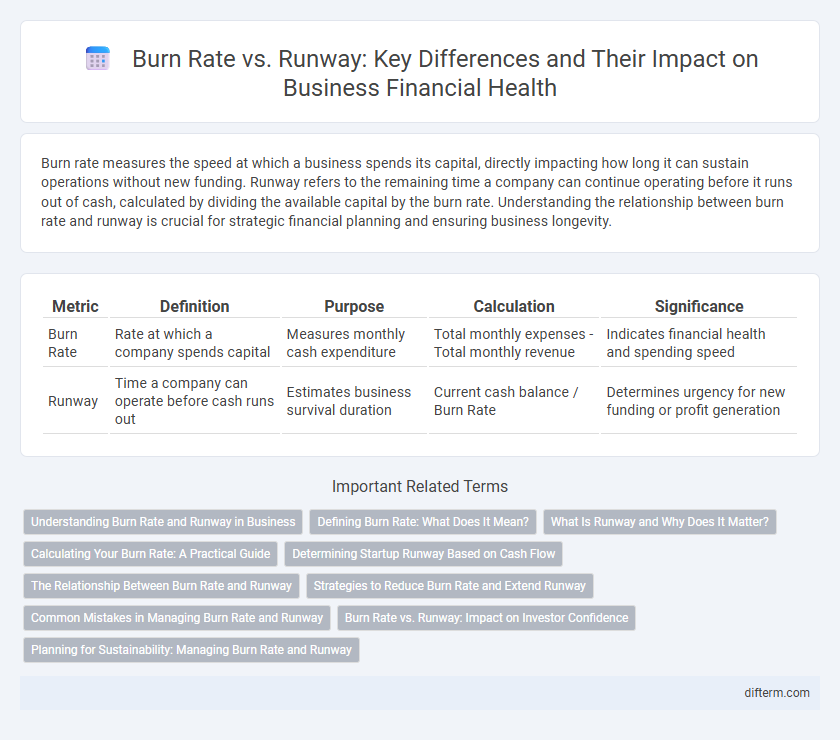Burn rate measures the speed at which a business spends its capital, directly impacting how long it can sustain operations without new funding. Runway refers to the remaining time a company can continue operating before it runs out of cash, calculated by dividing the available capital by the burn rate. Understanding the relationship between burn rate and runway is crucial for strategic financial planning and ensuring business longevity.
Table of Comparison
| Metric | Definition | Purpose | Calculation | Significance |
|---|---|---|---|---|
| Burn Rate | Rate at which a company spends capital | Measures monthly cash expenditure | Total monthly expenses - Total monthly revenue | Indicates financial health and spending speed |
| Runway | Time a company can operate before cash runs out | Estimates business survival duration | Current cash balance / Burn Rate | Determines urgency for new funding or profit generation |
Understanding Burn Rate and Runway in Business
Burn rate measures the rate at which a company spends its available capital, typically expressed as monthly cash outflow. Runway indicates the amount of time a business can continue operating before it exhausts its cash reserves, calculated by dividing the current cash balance by the burn rate. Understanding both burn rate and runway is critical for effective financial planning and ensuring sustainable business operations.
Defining Burn Rate: What Does It Mean?
Burn rate refers to the rate at which a company spends its available capital to cover operational expenses before generating positive cash flow. It is a critical financial metric that indicates how quickly a startup or business is consuming its cash reserves. Understanding burn rate helps businesses forecast their runway, ensuring they have sufficient funds to reach key milestones or secure additional financing.
What Is Runway and Why Does It Matter?
Runway represents the amount of time a business can operate before exhausting its available cash reserves, calculated by dividing current cash balance by monthly burn rate. It matters because it directly influences strategic planning, funding decisions, and the business's ability to sustain operations during periods of growth or market fluctuations. Effective management of runway ensures companies maintain financial health and avoid insolvency risks.
Calculating Your Burn Rate: A Practical Guide
Calculating your burn rate involves tracking total monthly expenses and dividing them by the number of months to determine the average cash outflow. Understanding burn rate is essential for accurately estimating your runway, which indicates how long your business can operate before exhausting its cash reserves. Monitoring these metrics enables effective financial planning and ensures sustainable business growth.
Determining Startup Runway Based on Cash Flow
Calculating startup runway requires analyzing burn rate, which measures monthly cash expenditure, to estimate how long available capital sustains operations. Accurate cash flow forecasting integrates fixed and variable costs, projecting financial runway essential for strategic planning and investor communications. Maintaining a detailed burn rate model directly influences fundraising timelines and operational adjustments to extend business viability.
The Relationship Between Burn Rate and Runway
Burn rate directly impacts runway by determining how quickly a company's available capital is depleted over a specific period. A higher burn rate shortens the runway, limiting the time a business can operate before needing additional funding. Understanding this relationship allows companies to manage expenses effectively and plan for sustainable growth.
Strategies to Reduce Burn Rate and Extend Runway
Reducing burn rate involves cutting non-essential expenses, optimizing operational efficiency, and renegotiating vendor contracts to lower cash outflows. Extending runway can be achieved by increasing revenue through strategic partnerships, early customer acquisition, and exploring alternative funding options such as bridge loans or convertible notes. Regular financial monitoring and scenario planning allow businesses to proactively adjust spending and fundraising efforts to maintain a negative burn rate for as long as possible.
Common Mistakes in Managing Burn Rate and Runway
Mismanaging burn rate by underestimating operational expenses often leads to an inaccurate runway projection, putting startups at risk of sudden capital depletion. Ignoring variable costs and failing to regularly update financial forecasts impede effective cash flow management and strategic decision-making. Overlooking the importance of building a buffer for unforeseen expenses reduces the runway's reliability and threatens business sustainability.
Burn Rate vs. Runway: Impact on Investor Confidence
Burn rate directly influences a startup's runway, determining how long the business can operate before requiring additional capital. A high burn rate shortens the runway, creating urgency and potential risk that can undermine investor confidence. Maintaining a controlled burn rate extends the runway, signaling financial discipline and increasing appeal to potential investors.
Planning for Sustainability: Managing Burn Rate and Runway
Effective management of burn rate directly impacts the runway, determining how long a business can sustain operations without additional funding. Accurate forecasting of expenses and revenue streams helps optimize runway, enabling strategic decisions for sustainable growth. Monitoring these financial metrics closely ensures timely adjustments to spending, protecting the company from premature cash depletion.
Burn Rate vs Runway Infographic

 difterm.com
difterm.com